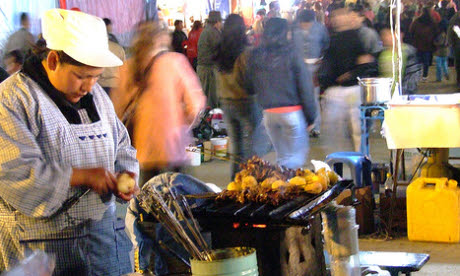
There's more than maize in this tasty South American country. Bibiana Tellez-Garside shares her favourite bites on-the-go
Api is a gloopy purple maize drink – it may not sounds appetising but it is very tasty – with cinnamon and sugar. The perfect accompaniment are hot fried fritters (buñuelos), which come in both sweet or savoury flavours and are often stuffed with cheese.
Found all-year-round in most Bolivian cities, in both restaurants and at street-food stalls, api is normally served for breakfast. Originally from the Altiplano, there's nothing like waking up to a warm, filling, sort-of-smoothie in the chilly mountains.
The enticing smell of a good llaucha stand is hard to walk past. Warm, pizza-dough pasties are filled with an oozing cheese sauce and make a comforting breakfast on-the-go in La Paz, where mornings can be cold.
Pick a busy place to buy one and go early before they sell out. But watch out, some of the city's less-reputable bakers make their llauchas a lot less cheesy, which makes them a lot less tasty.
Giant puffed white corn often coated with sugar, this is Bolivia’s super-sweet take on popcorn and a great snack to take on long bus rides. Pasankallas are less crunchy than popcorn, but still just as addictive.
Great bags of the stuff can be found at most confectionery stands in La Paz, where the high altitude creates just the right low air pressure for perfect popping.
Don't miss these cobs of giant white corn served hot with salty home-made cheese. This is a seasonal treat available from December until March, when the cobs are harvested, with the tastiest coming from the central region near Cochabamba.
Choclos are more often found in markets and eaten as a mid-morning snack – think the Bolivian version of Elevenses. They are not as sweet-tasting as the smaller, yellow cobs found in the UK but are more filling.
These ubiquitous pasties get their name from the Argentinian town, Salta, but are unmistakably Bolivian in identity and can be found all over the Andean half of the country.
The snacks are baked and usually filled with meat, spices, potatoes, egg, olives and a distinctive sauce. It takes a bit of practice to eat them without dribbling juices all down your shirt, so watch the locals’ tried-and-tested slurpy techniques – don’t even think about using a knife and fork.
If you only remember one thing, it's to sit and eat rather than munch on-the-move. Many places that only sell salteñas will have places to sit.
A very similar snack to salteñas, except Tucumanas are fried. Served all year round as a mid-morning snack, you'll find them on street food stands at every street corner. The best bit? They're presented with a variety of spicy and colourful dips, pickles and condiments for you to sample.
To munch the best spicy-green dipping sauces, head for Mexico Street in La Paz. Make your way to the top of the stairs – here you'll find a recommended street food stop. Don't believe us? When you see the queues of people you will.
Many markets have fresh fruit-juice stands where you pick out fruits trucked from the Amazon region. Servers will blend and squeeze your choices in front of you, either with a little water or, for a more filling alternative, with milk.